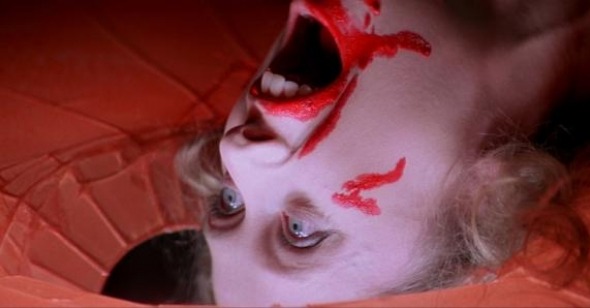Witching Hour
Fernando F. Croce on Suspiria
The world in Suspiria is so threatening and unstable that colors glow with sinister intensity, the camera moves as if possessed, and natural sounds abruptly give way to jangly music—and that’s just the first minute or so, which depict nothing more than the young protagonist, New York ballet dancer Suzy Bannion (Jessica Harper), strolling out of a German airport terminal. The doors slide open and the pitch-dark night welcomes her, wind and thunderclap and all. As she rides a taxi and psychedelic raindrops clobber the windows, the feeling is less of a wide-eyed coed visiting a new country than of Proserpina returning to the Underworld. Dario Argento’s earlier films never starved for eruptions of the horrific within the ordinary, yet their backdrops had been, even at their most outré, recognizably “normal.” Suspiria is a conscious heightening of style: not for nothing does a character at one point refer to a period when ballet became a “different, more stylized” art form. Here, the Italian director dispenses with reassuring realism from the start, dropping the viewer along with the heroine into a cacophonous maelstrom that refuses to separate the ravishing from the appalling.
Suzy arrives at the Freiburg Dance Academy just as another student is scrambling out, her screams half-drowned out by the storm. Later that night, the girl and a friend are slaughtered by a shadowy entity, their gory deaths turned into a spiraling set piece as perversely aestheticized as anything by Argento mentor Mario Bava. However, where blood spread elegantly on the surface of bathtub water like a blossoming rose in Bava’s Blood and Black Lace, in Suspiria it gushes from the victims like Pollock splashes—one is classical symphony, the other guerrilla theatre. Back at the Academy, Suzy is introduced to the two reigning harpies, Miss Tanner (Alida Valli, her gray uniform and severe smile giving more than a hint of frau kommandant) and Madam Blanc (Joan Bennett, who played the inquisitive ingénue role thirty years earlier in Fritz Lang’s superb Secret Beyond the Door). The most mundane scenarios churn with uncanny menace. The building’s geography seems to fluctuate from scene to scene, and creepy mysteries lurk in every frame. The reflection from a glass shard can cause Suzy to hemorrhage in class, and the cups of gooey wine prescribed by a doctor as part of her recovery loom in the foreground like Suspicion’s famous glass of milk.
With the discovery of a coven of witches residing in the academy, Suspiria introduces the supernatural to Argento’s universe. To the obsession with obscured sight and perception from his earlier giallo thrillers, the film adds a sense of dark parallel worlds behind the thin veneer of “order.” When a specialist on the occult (a young Udo Kier, miraculously one of the saner characters on screen) says “magic is everywhere,” the distinctive blend of fear and excitement brings to mind Kyle MacLachlan’s “It’s a strange world” line from Blue Velvet. (Also like David Lynch, Argento fills his canvases with insect life. Maggots rain down from the academy’s decaying attic onto the hysterical students, adorning their Pre-Raphaelite tresses with squirmy white specks.) Silhouetted behind an infernal orange curtain, the elusive head witch Helena Markos snores with unforgettable raspiness while Suzy and her roommate Sara (Stefania Cosini) cower in bed. To judge from the lurid Technicolor hues and the serpentine tracking shots throughout, this ancient sorceress’s magic appears to have infected the director’s camera as well. A neurotic imagist with an opulently debauched sensibility, Argento keeps the disorienting images and sounds at continuous play, with the prog-rock band Goblin supplying a twinkly-screechy score that suggests a Black Mass surrounded by music boxes.
The first installment in a mystical-themed trilogy (Inferno and Mother of Tears are the two later panels), Suspiria is arguably Argento’s masterpiece, an instance of an alchemical mise-en-scène engulfing and transforming what is, by most traditional standards, an essentially disjointed narrative. Confrontationally visceral, it also has a bizarrely fanciful side resulting from the filmmaker’s fascination with fairy-tale fantasies, Disney’s Snow White and the Seven Dwarfs in particular. Indeed, the original plan was to set his story in a boarding school for prepubescent girls, an idea eventually realized in Phenomena; changes were made to avoid controversy, but the heady combo of burgeoning female sexuality and the threat of death still lingers pungently in the film’s many crawlspaces. In moments like Suzy’s deciphering of the murdered girl’s aural clues or her showdown with the cackling Helena in the midst of porcelain explosions, Suspiria becomes a work of fierce demonic splendor, making tangible the subterranean anxieties inherent to the horror genre in a tremendous sensory assault. The incendiary finale is transcendentally apt: It takes an artist who’s willing to gleefully burn down the world he so meticulously constructed to make beauty and terror leak into each other with such force.
Suspiria played November 2 and 3 at the Museum of the Moving Image as part of the series See It Big, copresented by Reverse Shot.
